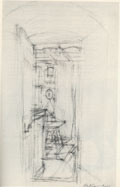|
| What's a "Line"? |
|
 |
You might remember from high school geometry that a line consists of two points. How can we extend this rather conceptual definition to describe "line" as an element in art? Your 2D design book gives us a great way to think of lines:
|
Theoretically a line is an extended dot; so, if only one person shows up, a dot is made. But, as other people are added, with their different dimensions and positions, the line's characteristics change. In art, these line variations are called "physical characteristics," and they can be used by the artist to create meanings as well as to reproduce the appearance of the artist's subjects. (Ocvirk, et al., p.74.)
|
|
|
 |
|
Marden
|
|
Just imagine the different materials you can use to draw or make a line, and consider that various types of lines each will make. For example, a charcoal line will look different from a pen line. Sand laid on a floor will create a different line than a rope hanging from the ceiling. The line we perceive along the edge of a cement block feels very different from a line made by a brush soaked in paint dragged across the surface of a canvas.
|
|
| What do lines do? |
|
. |
LINE is a very important record of feeling or document of implied action. LINES speak: the directional energy of both visible an invisible lines is capable of communicating messages of speed and direction.
"Invisible" lines (or implied lines or imaginary lines) trace paths of motion across the visual field. Invisible lines are very powerful, yet may not affect everyone exactly the same way.
| Consider, for example, the symbolic or associative feelings/nuances of: |
|
|
|
|
Horizontal lines |
still, asleep, inert, silent |
|
Vertical lines |
awake, alive, vital |
|
Diagonal lines |
movement, action, dynamic |
|
Straight lines |
rigidity, stiffness, formality or directness |
|
Curved lines |
organic and man-made |
|
|
 |
|
Giacometti
|
|
|
|
 |
|
|
|
|
